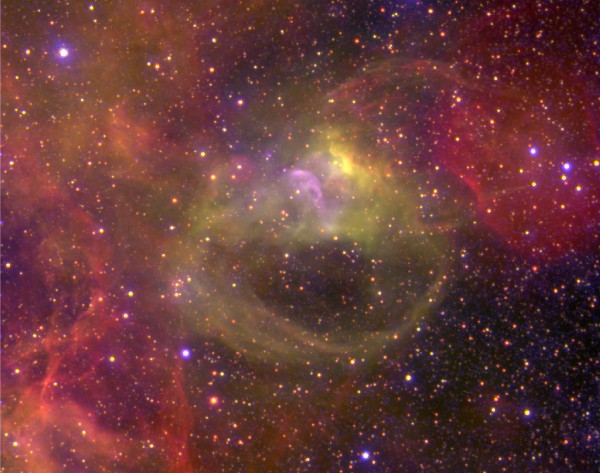Credit & Copyright: Y. Naze, G. Rauw, J. Manfroid, J. Vreux
(Univ. Liege),
Y. Chu (Univ. Illinois),
ESO
Explanation:
Blossoming in nearby galaxy the
Large Magellanic Cloud (LMC), this
gorgeous nebula is energized by radiation and winds from
a massive star whose surface temperature approaches 100,000 degrees.
The
composite color image
from the European Southern Observatory's
Melipal telescope
resolves details in the energetic nebula, with emission
from helium atoms in blue hues, oxygen atoms in green, and
hydrogen atoms in red.
While
emission nebulae
generally show the familiar red light from
ionized hydrogen atoms - hydrogen atoms with
their
electrons stripped away - ionized helium atoms are tracers
of even higher energy interactions.
The intriguing filaments of helium emission make this and other
recently studied emission nebulae most
exceptional.
A Wolf-Rayet star,
the massive star powering this nebula,
created a cosmic bubble
with stellar winds in the early stages
of its life.
Part of the bubble is still apparent as the large arc
in the lower portion of the image.
The area pictured is about 150 light-years across.
Have you seen today's:
THEMIS Image of Mars?
1999 2000 2001 2002 2003 2004 2005 2006 2007 2008 2009 2010 2011 2012 2013 2014 2015 2016 2017 2018 2019 2020 2021 2022 2023 2024 2025 |
Yanvar' Fevral' Mart Aprel' Mai Iyun' Iyul' Avgust Sentyabr' Oktyabr' Noyabr' Dekabr' |
NASA Web Site Statements, Warnings, and Disclaimers
NASA Official: Jay Norris. Specific rights apply.
A service of: LHEA at NASA / GSFC
& Michigan Tech. U.
|
Publikacii s klyuchevymi slovami:
emission nebula - LMC - Wolf-Rayet star - BMO - Bol'shoe Magellanovo Oblako - emissionnaya tumannost' - zvezdy Vol'fa-Raie
Publikacii so slovami: emission nebula - LMC - Wolf-Rayet star - BMO - Bol'shoe Magellanovo Oblako - emissionnaya tumannost' - zvezdy Vol'fa-Raie | |
Sm. takzhe:
Vse publikacii na tu zhe temu >> | |
